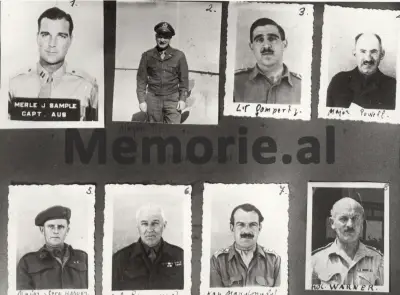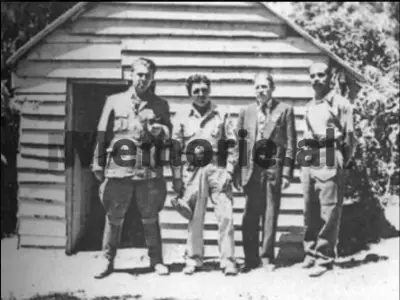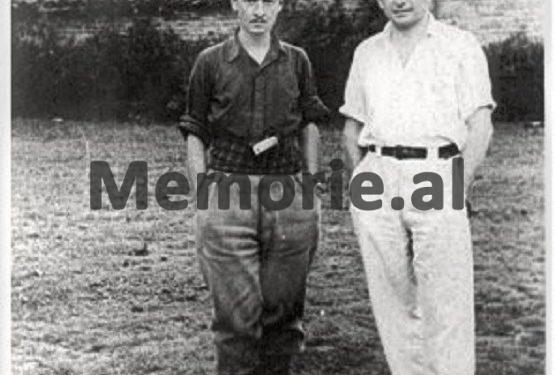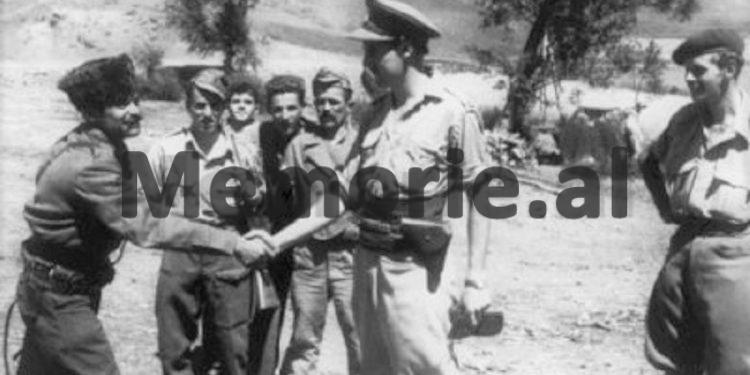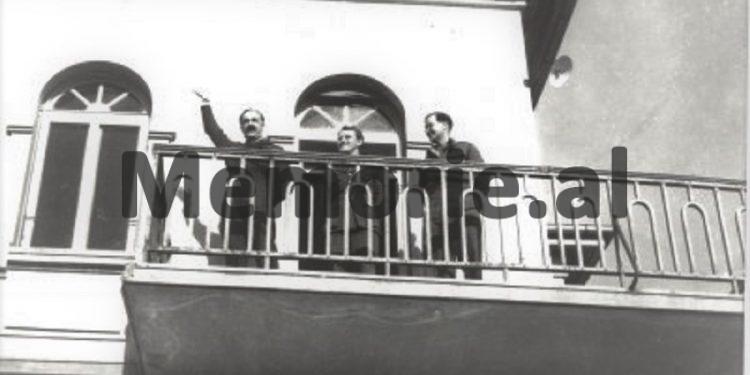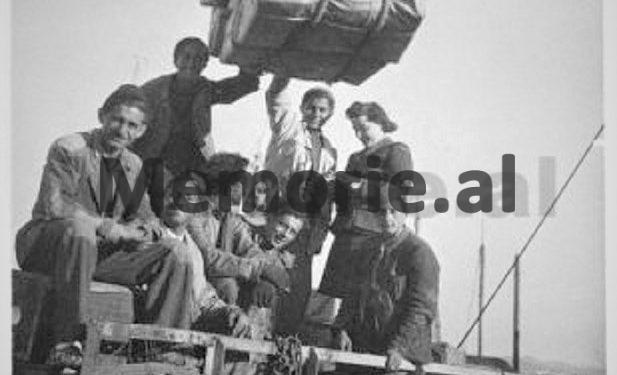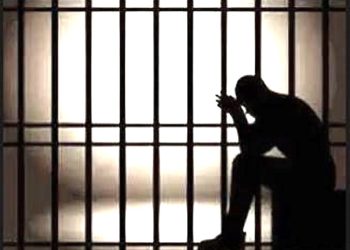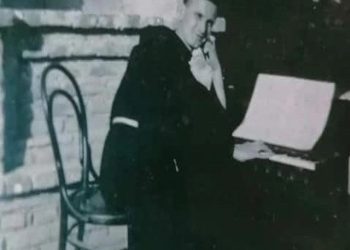Dashnor Kaloçi
Memorie.al publishes an archival document with the unknown files of the activity of the Anglo-American allies in our country during the War period, 1943-1946, issued by the Central State Archive, the fund “Activity of the Anglo-American allied missions in Albania”, where light is shed on their decisive contribution to the complete liberation of Albania from the Italians and the Germans. How dozens of allied planes crashed in Albania, being captured by hundreds of paratroopers as well as civilian casualties in various cities in Albania
During the period of the Second World War, the Anglo-American allied forces took an active part since the beginning of the anti-fascist resistance in Albania, joining the first nationalist and partisan factions, they financed and regularly supplied money, clothing, medical equipment, ammunition, armaments, combat techniques, and everything else that the forces of that resistance needed in our country. The Anglo-American Allies carried out hundreds of air incursions, bombing incessantly all German troops and installations everywhere in all the provinces, villages and towns throughout the territory of Albania at that time, including those located on Mount Black, Kosovo and Macedonia.
And as a result of all this commitment, during the years 1943-1946, in the territory of Albania alone, several dozen allied planes were shot down, killing, capturing Germans, or disappearing without a trace, several hundred Anglo-American soldiers… Most of them later ended up in the crematoria of Auschwitz, Mat’hausen, Dakao, or other extermination camps set up by Hitler’s Nazis in various European countries. But all this, for Enver Hoxha and his communist regime, had value until 1946, when the war was over and he no longer needed them.
At that time Hoxha severed all relations with the Anglo-Americans, and then everything they had done for Albania was erased as if they had never existed. From that time until the beginning of the ’90s, the official historiography and propaganda of the communist regime of Enver Hoxha, not only reflected their help and role in Albania as extremely sporadic, but on the contrary: considered them as an obstacle in the Anti-Fascist War, identifying them as “traitors and renegades” of their communist cause and ideals. As a result of all this propaganda for almost half a century, which unfortunately still continues today, in the image and imagination of most Albanians, the Anglo-American allies are the ones who “threw two shoes on one foot”, or spoiled biscuits and chocolates, “helping only their agent, Cana Basin”.
Based on what we said above, without wanting to glorify their role, and to deny or minimize the role and contribution of all those Albanians who rose up and fought against foreign invaders during the years of World War II, but with the sole purpose of illuminating and shedding some light on the truth, Memorie.al. from this issue onwards, will publish a series of archival documents extracted from the Central State Archive in Tirana (which before the 90s were “Top Secret” and were never opened), which reflects the most well, all the Anglo-American activity in Albania. We are publishing some of them in an integral way and without any cuts, in order to create a clearer idea of their role and that of Albania at that time.
The first Anglo-American missions in Albania and aid to partisans
According to archival documents which correspond to the memoirs of some of the former Anglo-American missionaries in Albania, (first published in the USA and England, and later in Tirana) the idea to penetrate the Anglo-American military in Albania, was thrown by Jualian Amery since 1940, when he served as military attaché at the British Embassy in Belgrade. While the first military to invade our country, was: Oakley Hill, who in April 1941, together with brothers, Said, Gani and Hasan Kryeziy, as well as with Abaz Kupi and Mustafa Gjinishi crossed the Albanian border from Yugoslavia. The first missile mission in Albania was launched two years later, in April 1943, when Billy McLean, Garry Duffy, Williamson and David Smajl, from Greece entered our country. This was followed by many other groups of missionaries, who immediately came into contact with the main nationalist and National Liberation Movement leaders who had, or were creating, the first squads to fight against the Italian invaders.
This is also confirmed by many archival documents of the fund “Activity of allied Anglo-American missions in Albania”, where the British missionaries had reached Nikaj i Mërturit, making propaganda or organizing anti-fascist resistance. After organizing this resistance, they turned to concrete aid, responding to almost all the demands of the main exponent of the Anti-Fascist Movement in Albania. This is clearly confirmed in an archival document dated 3.VIII.1944, where the Deputy Prefect of Berat, Captain I, Gani Jashari, notifies the Political Office of the Ministry of Interior in Tirana, which reads:
“We have reliable information that the English in Skrapar in recent days have increased the discharges of all kinds of material and food in the basic area Staravecka based in Helmës. For several days, the Seventh Brigades and many units of different Brigades such as Kurvelesh, Zagoris and others have gathered in the village Therepel where they have organized the strengthening and training with heavy artillery weapons and plague. The vanguards of these powers today are dictated in the villages closest to this city. From this information it turns out that the reds throughout the area controlled by them have made the general mobilization. All these preparations they make for the attack and occupation of this city. As coping with their powerful attack with the forces we have today seems extremely difficult, please intervene as soon as possible to send another sufficient force” (AQSH. Fund 152. Year 1944. File 866. Fl. 26)
Anglo-American bombing of German forces
The peak of the activity and contribution of the Anglo-American allies in Albania, reached in the years 1943-’44, when they intensified the blows against the Germans through air bombardment incursions. Regarding this, it is also mentioned in an archival document dated 29.IV.1944, where the Prefect of Elbasan, Lutfi Shehu, in a notification to the Ministry of Interior in Tirana, writes: on the 15th of this month, foreign planes fired on the Librazhd-Prenjas road, especially the barracks where German soldiers are located; in the center of Librazhd, four German soldiers were killed and along the upper road, 14-15 military vehicles were burned and destroyed, and in Prrenjas, eight German soldiers were killed. Add that so far there is a lack of information to the detriment of the civilian population; The end has been announced to you”. (AQSH. Fund 152, Year 1944. File 374. Fl.102)
In another archival document of this nature, it is written: “Albanian state. Puka sub-prefecture. No.25 / 22. CONCEPT. Puka on 1.7.1944. P.T. Prefecture. We have the honor to inform you that About the local command as after the announcement qi ban informs us that on 29 / VI / 944 at 19.30 British planes have machine gunned German military targets, barracks, cars, in the center of Puka and along the road Puka-Rrapë hunt 8 military vehicles burned down your military convoy. No damage has been caused to the people.
Deputy Prefect (Et’hem Rrema) seal firm).
(AQSH. Fund 346. Year 1944. File 65. Fl. 135.)
Also, in a document that talks about the bombing of German forces, it says: “Albanian state. Elbasan Prefecture. Elbasan on May 8, 1944. Municipality of Kl.I-r Librazhd. Nr.125. Librazhd on 29 / IV.1944. P.T. Elbasan Prefecture. We have the honor to inform you that today at 3 and 5.30 after lunch the center of this municipality was bombed and machine-gunned, but fortunately this time during these aerial incursions not a single victim was provoked among the people. Since the buildings where the German army resides are 15-25 meters close to the Government offices, the market and the family dwellings from these, the windows and windows of the above-mentioned buildings have been damaged many of them. Since the market of this commune is located at the intersection of three important roads, and geographically and surrounded by mountains and high hills in the vicinity of 200-300 meters from the market, after the army and the place where the military material was placed, it is very close to the Government offices. , the market and family dwellings, therefore the effects of the bombing are severe and very dangerous for the market population, however protective shelters. From these circumstances the market population and the Employees are quite shocked. If the bombing continues, operation in the center will be impossible. Since the position of the country is very difficult and small and by no means allows the army to be placed in the buildings of the market here or a place for storage of military material as they are dictated very easily. So, in order to save the people of the market from this horror, please demarcate where it should, so that these buildings are emptied as soon as possible and as the army and military material are placed in sheltered places at least 1500-2000 M. away from the market after there are very convenient places. Mayor Ibrahim Dedja d.v.
(AQSH. Fund 152. Year 1944. File 374. Fl. 139)
350 Anglo-American planes in Pristina, hundreds of victims from the civilian population
There were numerous bombings by the allied aviation in the Albanian areas in Macedonia, Kosovo and Montenegro, where unfortunately, as in all other territories of Albania after 1913, there were numerous casualties from the civilian population. In this regard, it is also mentioned in an archival document dated 7.7.1944, where the Deputy Prefect of Prishtina, Reshit Mehmeti, in a notification to the Ministry of Interior in Tirana, writes:
“For your information, we have the honor to inform you that, on 23/6/44, a number of almost 350 foreign planes passed through this region, from where they were distributed in different directions: Serbia and Bulgaria. Shortly afterwards, two of those planes returned and dropped two bombs on the village of Pleshinë in Ferizaj, injuring two woodcutters, who have not yet been identified after being taken by the Germans and immediately taken to hospital. Also, after a while, two other planes returned, which dropped a machine gun in Babush and one in Shtime, Ferizaj, together with some machine gun tools, and were taken by the Germans. In the evening of the 24th of k.m. a number of planes flew over the city of Ferizaj and from there took the direction of Lubeten, on top of which a fire was burning. They were brought there for a few minutes. “It is possible that they threw war material at the communist gangs.”
In some other documents that belong to this file, other notifications are given to the prefecture of Prishtina, where it is known about many other bombings of allied planes, such as in Peja, Ferizaj Gilan, Gjhakovë etc. In addition to the extensive damage inflicted on German forces, there were dozens of civilian casualties (with lists corresponding to each city), as well as many downed Anglo-American aircraft and captive pilots captured by government and German forces.
Bombing against the Germans in Lezha
Numerous bombardments by the allies against the German forces took place in the city of Lezha and the surrounding villages. Regarding this, it is also mentioned in an urgent telegram dated 30.3.1944, where the Deputy Prefect of Wra, Major Llesh Marashi, notifies the Ministry of Interior in Tirana, writing: “The sub-prefecture of Lezha announces that from the bombings and “The population of Lezha has moved to foreign villages. Please let us know what measures should be taken for government offices in case of continuous incursions”. In another archival document of the District Commander of Wra, Major Llesh Marashi, dated March 28, 1944, by telegram no. 7/13, where he notifies the General Command of Brotherhood (Office III) in Tirana, it is said: “The district of Lezha informs us that yesterday at 11 o’clock pd in a place called Fusha Hani, on the banks of the Drin in the city of Lezha, a bombing was carried out by foreign planes, causing casualties and damages below point Surije Kruja, 10 years old, Muçe Kruja, 5 years old, Fildese Kruja, 3 years old, Alija Kruja aged 2 all children of Muhamet Kruja Lezha court secretary Esat Hamza aged 2 died, Istref Hamza seriously injured Nadire Hamza Hasan Rama children killed Halil Dini aged 60 died Donika Nikolla Karnese aged 35 died peak The buildings where these people lived “There were big checkpoints. Yes. On the road to Kakarriq, the enemy planes burned a German truck, but without any damage to people. The number of bombs dropped is 3, only one of them fell on the damaged building. Details with the report”. (AQSH. Fund 346. Year 1944. File 65. Fl 23.) In this file are also given
the numerous damages caused to the German forces in the villages of Zejmen, Rrilë, Shënkoll, etc., as well as the list of victims from the civilian population in the city of Lezha and the surrounding villages.
Bombings in Tirana, hundreds of victims from the civilian population
According to archival documents, the greatest intensity of Allied bombing of the Germans was in the Tirana Region. In this regard, in a document dated 5 April 1944, the Commander of the District Gendarmerie, Captain Xhelal Staravecka, notifies the Prefect of Tirana, Qazim Mulleti, writing: “We submit that on 30/3/1944, at 12 o’clock up to 13, 10 people were killed and 10 were injured by foreign planes, and 12 were seriously injured, of whom only Musa Hamzaj, son of Sali and Hanes, dl. 1926, born in the village of Nange of Bicaj e Lume, resident in Tirana, the coachman remains dead. Both the murdered and the palgosun after the incursion were sent to the civilian hospital for treatment of the murdered for burial after being identified. “The necessary orders have been given for the identification of the people killed and injured and they will finally be notified.” In another document with no. Protocol 50/11, dated 11.IV.1944, where the Commander of the Internal District, Tirana, Captain Xhelal Staravecka, notifies the Tirana State Prosecutor’s Office, among other things it is written: “It is submitted to you that on 30/3/1944, from the aerial incursion, three people were killed near the power plant, who had remained unidentified, and their bodies were transported to the Hospital, who were later identified and are: Ibrahinm Plaku, son of Musaj, and of the lady, dl . 31/12/1914, born in the village Marcinep of the Municipality of Preza, Durrës Prefecture workers. Maksut Ismaili, son of Beqir and Hanema, 40 years old, born and living in Marsenik, Durrës Prefecture, worker. Musa Sali Hamzaj from the village of Nangë i Lumës, dl.1 / 10/1926, former servant near Mehmet Qyqes in Tirana. The following items were found on the victims: Ibrahim Fr.Ar.123 together with the wallet were handed over to his uncle Vath Plaku. Maksutit Fr.ari 120-40 together with the wallet were handed over to Mehmet Qyqes from Tirana, after the victim had been with him for a long time and he had another obligation to the victim’s family. Minutes are kept on their identification and the delivery of the money is presented to you”. (AQSH. Fondi 152. Viti 1944. Dosja 374. Fl.76) /Memorie.al
Continues tomorrow




